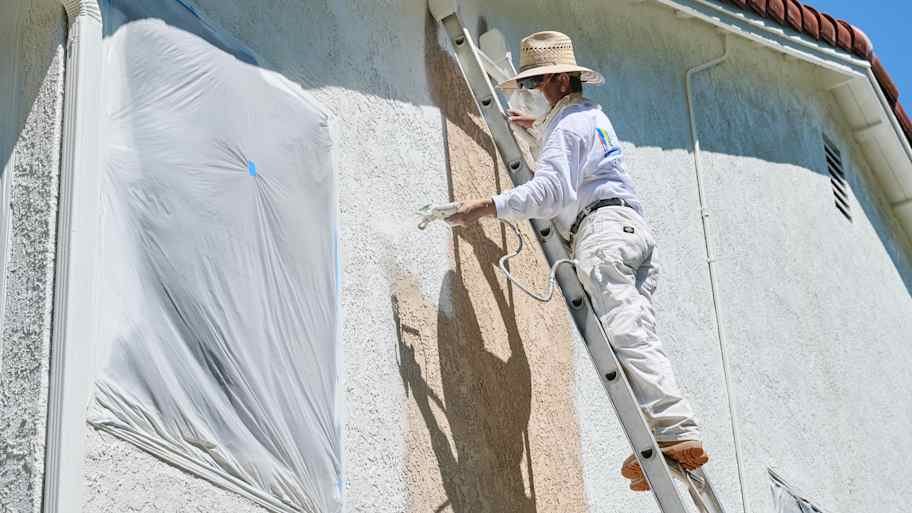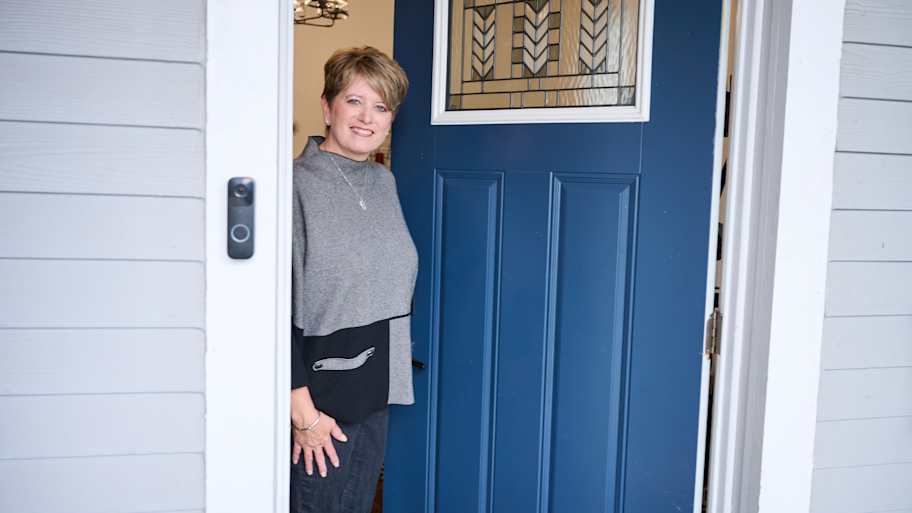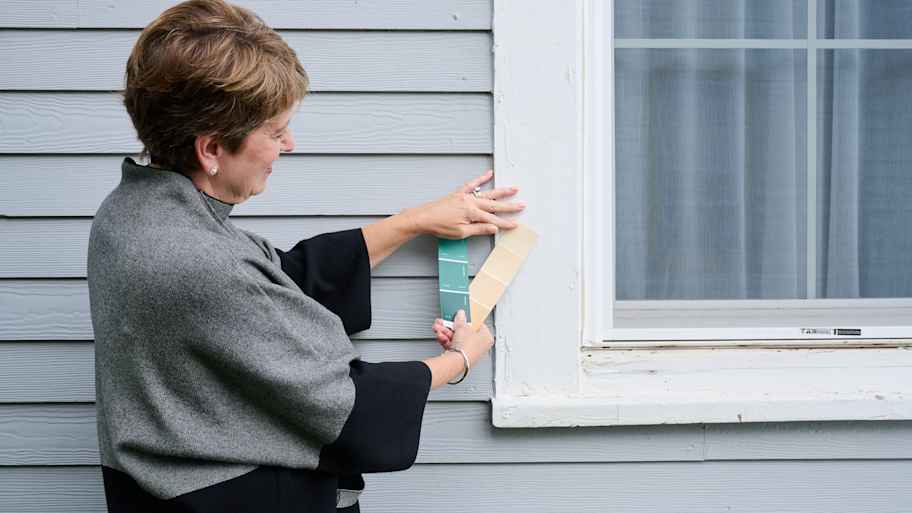How to Paint a Stucco House for Maximum Curb Appeal
Give your stucco home a facelift with a fresh coat of paint
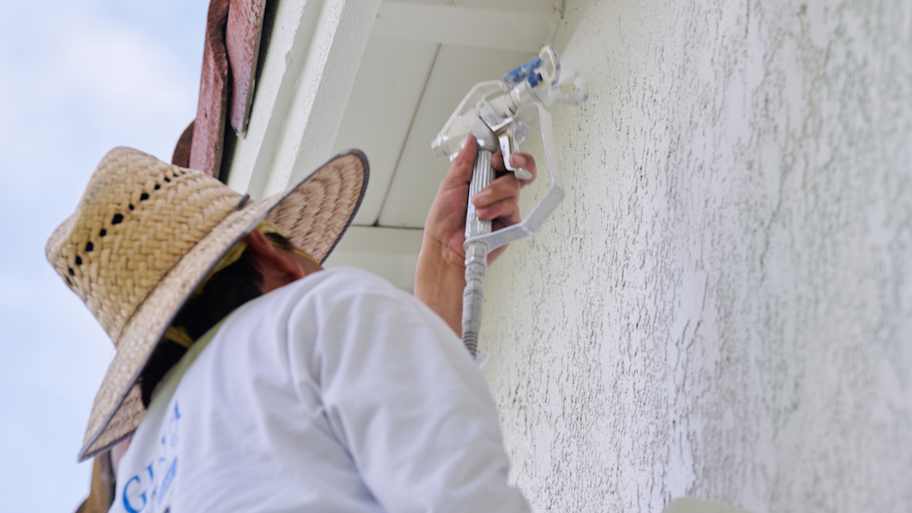

- Brush
- Buckets
- Paint roller frame
- Paint brushes
- Garden hose with spray nozzle
- Primer
- Acrylic paint
- Stucco cleaning solution
- Painter’s tape
- Gloves
Whether you’re refreshing the current color or changing the color of your stucco entirely, a fresh coat or two of paint can go a long way toward improving your home’s appearance. Although painting a stucco house can be labor intensive, especially if you’re painting the entire exterior of your home, you can DIY this if you have the time, tools, and do a bit of research to get you through each step of the process. So it’s a good thing you’re here, because we’ll walk you through the steps of how to paint a stucco house using the best paint for stucco (see later in the article, after the how-to steps).
Prep the Work Area
Clear the area you’ll be working in. Lay down tarps to protect any plants, landscaping, pavement, or decking. If you need a ladder or scaffolding to reach some of the stucco, consider calling a professional painter as working on ladders can be dangerous, and scaffolding can be costly and time-consuming to rent as well as assemble and disassemble and move. Another option is to rent a painting lift, which typically costs $100 to $650 per day.
Sand (Optional) and Clean the Stucco
If your stucco has existing paint on it, use 80- to 100-grit sandpaper to rough up the existing paint to help the new paint adhere. An important part of prepping any paint project is to make sure to clean the surface you’re painting. Dirt, debris, grease, and other materials can keep the paint from sticking, so cleaning the stucco will help the paint adhere more securely, extending the life of the paint. Clean the stucco with a soft-bristle brush and a cleaning solution that’s approved for stucco. Rinse with a garden hose and spray nozzle. Try to avoid using a pressure washer unless you have experience, because a pressure washer could possibly damage the stucco if held too closely or at a pressure too high for the material to withstand.
Repair the Stucco
Inspect the stucco for any cracks, chips, or loose material. Hairline cracks will usually be filled in when you paint the stucco, but you can fix stucco cracks that are slightly larger with caulk. Patch any chips with a stucco patch material. If you find wide cracks (¼” or more) or large amounts of stucco material peeling or flaking off, you may have moisture or shifting problems that a professional stucco contractor should assess. Allow any caulk and patch material to dry for the manufacturer’s recommended amount of time.
Apply Painter's Tape and Plastic
 Photo: Romar66 / Adobe Stock
Photo: Romar66 / Adobe StockWhile the caulk and patch material dries, apply painter’s tape around the edges of the stucco to keep from getting paint on windows, trim, and other adjacent surfaces. Taking your time to tape neatly will help save you time and give you crisp lines. Tape painter’s plastic over any windows or other surfaces that might get paint splatters or drips.
Roll on Primer
Stir the primer and pour it into the paint tray with a liner (for easy cleanup and switching to paint). Use a 3-inch paintbrush to cut in the edges. Then roll a coat of primer on the rest with a ¾ to 1-½ inch nap roller cover to make sure the paint gets into the deeper crevices in the texture. Apply one coat and allow the primer to dry for the amount of time recommended by the manufacturer.
Apply Acrylic Paint
The best type of paint to use on stucco is acrylic, because it’s durable as well as breathable. Breathability is important because it doesn’t trap moisture that can cause mold and deterioration. As with the primer, cut in the edges with a paint brush. Then roll a coat of acrylic paint on with a 3/4-inch to 1 1/2-inch nap roller cover. Work in smaller areas to avoid letting the edge of the paint dry. Maintaining a wet edge helps the paint blend and avoids lines in your paint job. Allow the first coat of paint to dry for the amount of time recommended by the manufacturer.
Roll on Second Coat of Paint
 Photo: hxdbzxy / iStock / Getty Images Plus / Getty Images
Photo: hxdbzxy / iStock / Getty Images Plus / Getty ImagesAfter the first coat is dry, repeat the same process as the first coat for the second coat. Again, allow the second coat to dry for the recommended length of time.
Remove the Painter’s Tape and Clean Up
Once the second coat has dried for the recommended amount of time, gently remove the painter’s tape to avoid damaging the edge of the paint. Remove the painter’s plastic and dispose of the tape and plastic. When considering the cost to paint stucco, remember that prep and cleanup should be included as part of the job.
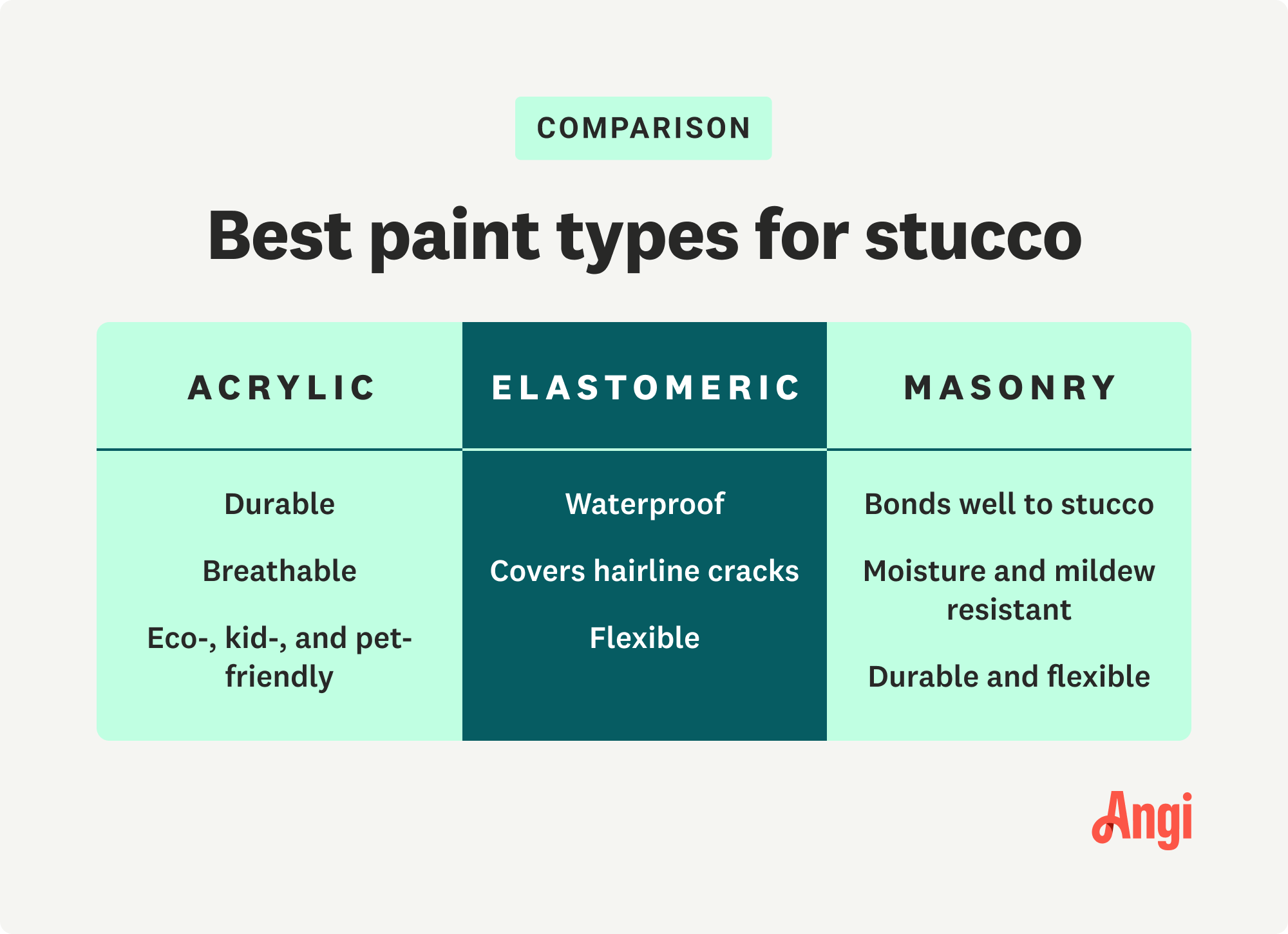
Mistakes to Avoid
When preparing to paint stucco, you need to avoid making a few common mistakes to ensure the highest-quality results
Not repairing any large cracks properly: If you have cracks that are thicker than a credit card, they need repair beyond simple caulking. Consider calling a local stucco repair company to open up the material and patch it properly.
Not letting the repairs cure: If you must make major repairs to the stucco, you need to let it cure and harden before painting it. This can take at least 15 days. Check the instructions with the patching material for exact recommendations. Plan accordingly for the timeline of the job if you need to make repairs before you can paint.
Not waiting long enough for new stucco to cure: Before painting a new stucco installation, you need to let the material harden and cure, which can take at least 60 days. In a dry climate, a thin layer of stucco may cure faster, while a thicker layer of stucco in a humid climate may take longer.
Not waiting for each coat of paint to dry: Because stucco is so porous, it needs more time to dry between coats of paint than other materials. Let the primer or any coats of paint dry completely before adding a new coat.
DIY vs. Hiring a Pro
Many painting projects can be DIY, depending on the size and complexity of the prep and painting involved. Painting the exterior of your home can require working on ladders, scaffolding, or lifts, which can be dangerous and quite labor intensive. Something larger in scope is probably more suited to a local professional exterior painter. While you may save on the labor cost by doing it yourself, the time and potential for costly mistakes may be worth the price of a pro. On average, the cost to paint a house exterior ranges from $1,900 to $4,500.
Frequently Asked Questions
When done correctly, a roller or paint sprayer can be used to paint stucco. Rolling paint works well on smaller projects, while a sprayer is more efficient for larger jobs. With some practice, a homeowner can rent an airless sprayer to paint stucco, but a larger job may be best done by a professional painter. Smaller areas are more manageable for the DIY homeowner.
The best exterior paint finish for stucco is a flat or low-gloss finish. A high-gloss finish will show imperfections in the stucco and give it a candy-coated look that many homeowners don’t like. The best types of exterior paint to use on stucco are acrylic, masonry, and elastomeric. However, acrylic is recommended because it is both durable and breathable.
Priming stucco before painting is not an absolute requirement, but applying a primer coat is recommended. Primer is designed to serve as a strong bonding agent between the stucco surface and the outer paint layers. Using a primer can also help produce even coverage and color for a better-looking final product.


